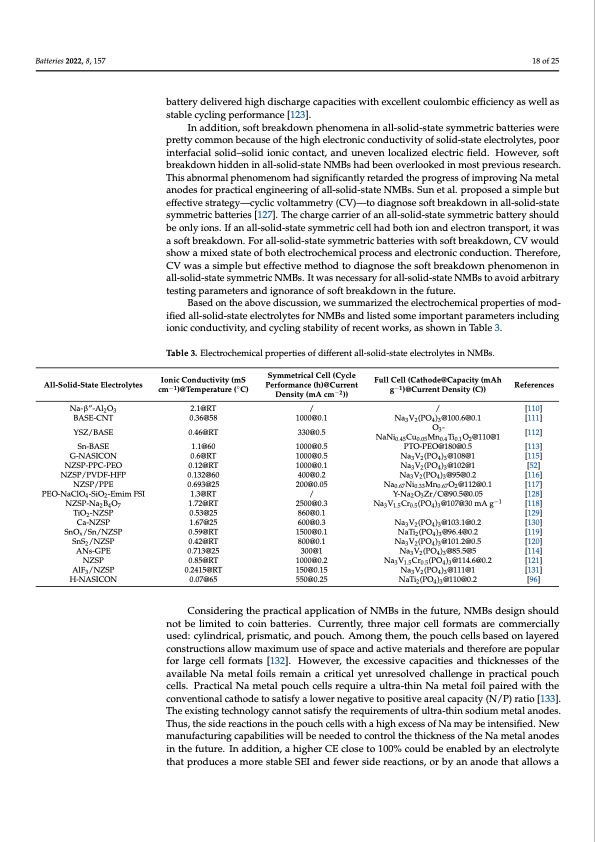
PDF Publication Title:
Text from PDF Page: 018
Batteries 2022, 8, 157 18 of 25 battery delivered high discharge capacities with excellent coulombic efficiency as well as stable cycling performance [123]. In addition, soft breakdown phenomena in all-solid-state symmetric batteries were pretty common because of the high electronic conductivity of solid-state electrolytes, poor interfacial solid–solid ionic contact, and uneven localized electric field. However, soft breakdown hidden in all-solid-state NMBs had been overlooked in most previous research. This abnormal phenomenom had significantly retarded the progress of improving Na metal anodes for practical engineering of all-solid-state NMBs. Sun et al. proposed a simple but effective strategy—cyclic voltammetry (CV)—to diagnose soft breakdown in all-solid-state symmetric batteries [127]. The charge carrier of an all-solid-state symmetric battery should be only ions. If an all-solid-state symmetric cell had both ion and electron transport, it was a soft breakdown. For all-solid-state symmetric batteries with soft breakdown, CV would show a mixed state of both electrochemical process and electronic conduction. Therefore, CV was a simple but effective method to diagnose the soft breakdown phenomenon in all-solid-state symmetric NMBs. It was necessary for all-solid-state NMBs to avoid arbitrary testing parameters and ignorance of soft breakdown in the future. Based on the above discussion, we summarized the electrochemical properties of mod- ified all-solid-state electrolytes for NMBs and listed some important parameters including ionic conductivity, and cycling stability of recent works, as shown in Table 3. Table 3. Electrochemical properties of different all-solid-state electrolytes in NMBs. All-Solid-State Electrolytes Na-β”-Al2 O3 BASE-CNT YSZ/BASE Sn-BASE G-NASICON NZSP-PPC-PEO NZSP/PVDF-HFP NZSP/PPE PEO-NaClO4-SiO2-Emim FSI NZSP-Na2 B4 O7 TiO2 -NZSP Ca-NZSP SnOx /Sn/NZSP SnS2 /NZSP ANs-GPE NZSP AlF3 /NZSP H-NASICON Ionic Conductivity (mS cm−1)@Temperature (◦C) 2.1@RT 0.36@58 0.46@RT 1.1@60 0.6@RT 0.12@RT 0.132@60 0.693@25 1.3@RT 1.72@RT 0.53@25 1.67@25 0.59@RT 0.42@RT 0.713@25 0.85@RT 0.2415@RT 0.07@65 Symmetrical Cell (Cycle Performance (h)@Current Density (mA cm−2)) / 1000@0.1 330@0.5 1000@0.5 1000@0.5 1000@0.1 400@0.2 200@0.05 / 2500@0.3 860@0.1 600@0.3 1500@0.1 800@0.1 300@1 1000@0.2 150@0.15 550@0.25 Full Cell (Cathode@Capacity (mAh g−1)@Current Density (C)) / Na3 V2 (PO4 )3 @100.6@0.1 O3- NaNi0.45 Cu0.05 Mn0.4 Ti0.1 O2 @110@1 PTO-PEO@180@0.5 Na3 V2 (PO4 )3 @108@1 Na3 V2 (PO4 )3 @102@1 Na3 V2 (PO4 )3 @95@0.2 Na0.67 Ni0.33 Mn0.67 O2 @112@0.1 Y-Na2 O3 Zr/C@90.5@0.05 Na3V1.5Cr0.5(PO4)3@107@30 mA g−1 Na3 V2 (PO4 )3 @103.1@0.2 NaTi2 (PO4 )3 @96.4@0.2 Na3 V2 (PO4 )3 @101.2@0.5 Na3 V2 (PO4 )3 @85.5@5 Na3 V1.5 Cr0.5 (PO4 )3 @114.6@0.2 Na3 V2 (PO4 )3 @111@1 NaTi2 (PO4 )3 @110@0.2 References [110] [111] [112] [113] [115] [52] [116] [117] [128] [118] [129] [130] [119] [120] [114] [121] [131] [96] Considering the practical application of NMBs in the future, NMBs design should not be limited to coin batteries. Currently, three major cell formats are commercially used: cylindrical, prismatic, and pouch. Among them, the pouch cells based on layered constructions allow maximum use of space and active materials and therefore are popular for large cell formats [132]. However, the excessive capacities and thicknesses of the available Na metal foils remain a critical yet unresolved challenge in practical pouch cells. Practical Na metal pouch cells require a ultra-thin Na metal foil paired with the conventional cathode to satisfy a lower negative to positive areal capacity (N/P) ratio [133]. The existing technology cannot satisfy the requirements of ultra-thin sodium metal anodes. Thus, the side reactions in the pouch cells with a high excess of Na may be intensified. New manufacturing capabilities will be needed to control the thickness of the Na metal anodes in the future. In addition, a higher CE close to 100% could be enabled by an electrolyte that produces a more stable SEI and fewer side reactions, or by an anode that allows aPDF Image | Recent Development for Sodium Metal Batteries

PDF Search Title:
Recent Development for Sodium Metal BatteriesOriginal File Name Searched:
batteries-08-00157-v2.pdfDIY PDF Search: Google It | Yahoo | Bing
Salgenx Redox Flow Battery Technology: Salt water flow battery technology with low cost and great energy density that can be used for power storage and thermal storage. Let us de-risk your production using our license. Our aqueous flow battery is less cost than Tesla Megapack and available faster. Redox flow battery. No membrane needed like with Vanadium, or Bromine. Salgenx flow battery
| CONTACT TEL: 608-238-6001 Email: greg@salgenx.com | RSS | AMP |